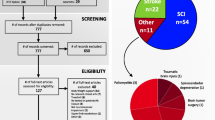Abstract
Wearable exoskeletons have generally been designed to enhance user strength or to reduce user fatigue. Two areas that have often been overlooked are that exoskeletons should increase user safety and have increased durability for use in extreme environments. In this paper, we developed an SMA spring-based shock absorption module for an exoskeleton or a quadruped walking robot, which can provide increased protection to the user during high-impact events in an extreme environment. We analyzed the impact force during the collision between the module and the ground based on impulse and momentum theories. The shock absorber module can be reused by exploiting the inherent shape memory characteristics of the SMA spring after every use. We confirmed that the spring constant of the SMA spring and the maximum allowable length affect the impulse reduction, and the results showed that the latter has a greater influence on impulse reduction.







Similar content being viewed by others
References
Tung, W. Y. W., McKinley, M., Pillai, M. V., Reid, J., & Kazerooni, H. (2013). Design of a minimally actuated medical exoskeleton with mechanical swing-phase gait generation and sit-stand assistance. In ASME 2013 dynamic systems and control conference, (pp. V002T28A004–V002T28A004). American Society of Mechanical Engineers.
Jezernik, S., Colombo, G., Keller, T., Frueh, H., & Morari, M. (2003). Robotic orthosis lokomat: A rehabilitation and research tool. Neuromodulation: Technology at the Neural Interface, 6(2), 108–115.
Esquenazi, A., Talaty, M., Packel, A., & Saulino, M. (2012). The ReWalk powered exoskeleton to restore ambulatory function to individuals with thoracic-level motor-complete spinal cord injury. American Journal of Physical Medicine and Rehabilitation, 91(11), 911–921.
McKinley, M. (2014). Design of lightweight assistive exoskeletons for individuals with mobility disorders (Doctoral dissertation, UC Berkeley).
Wandercraft. (2017). http://www.wandercraft.eu/en/. Accessed 5 Apr 2019.
Parker Hannifin Corp. (2017). Indego, from http://www.indego.com/indego/en/home. Accessed 5 Apr 2019.
Ekso Bionics. (2017). EksoGT, from http://eksobionics.com/eksohealth/products/. Accessed 5 Apr 2019.
Ekso Bionics, EksoVest https://eksobionics.com/eksoworks/eksovest/. Accessed 5 Apr 2019.
Kusuda, Y. (2009). In quest of mobility–Honda to develop walking assist devices. Industrial Robot: An International Journal, 36(6), 537–539.
Wehner, M., Quinlivan, B., Aubin, P. M., Martinez-Villalpando, E., Baumann, M., Stirling, L., et al. (2013, May). A lightweight soft exosuit for gait assistance. In 2013 IEEE international conference on robotics and automation (pp. 3362–3369). IEEE.
Rea, R., Beck, C., Rovekamp, R., Neuhaus, P., & Diftler, M. (2013). X1: A robotic exoskeleton for in-space countermeasures and dynamometry. In AIAA space 2013 conference and exposition (p. 5510).
Singularity Hub Website. (2010). http://singularityhub.com/2010/07/28/armyshulc-exoskeleton-to-test-at-end-of-2010-hints-at-industrialmedicaluses/—Army’s Hulc Exoskeleton to test at end of 2010, hints at industrial/medical uses. Aaron Saenz. Accessed 5 Apr 2019.
Ding, Y., Galiana, I., Asbeck, A., Quinlivan, B., De Rossi, S. M. M., & Walsh, C. (2014, May). Multi-joint actuation platform for lower extremity soft exosuits. In 2014 IEEE international conference on robotics and automation (ICRA) (pp. 1327–1334). IEEE
Martin, L. (2016). HULC-Exoskeleton suit, https://www.lockheedmartin.com/en-us/products/exoskeleton-technologies/military.html. Accessed 5 Apr 2019.
Raytheon XOS 2. https://spectrum.ieee.org/at-work/innovation/raytheon-sarcoss-exoskeleton-nears-production. Accessed 5 Apr 2019.
Raytheon XOS 3. https://spectrum.ieee.org/biomedical/bionics/the-rise-of-the-body-bots/0. Accessed 5 Apr 2019.
Kim, W., Lee, H., Kim, D., Han, J., & Han, C. (2014, October). Mechanical design of the Hanyang exoskeleton assistive robot (HEXAR). In 2014 14th international conference on control, automation and systems (ICCAS 2014) (pp. 479–484). IEEE.
HERCULE Exoskeleton Suit. http://www.rb3d.com/en/hercule-at-arma-suisse-switzerland/. Accessed 5 Apr 2019.
Zoss, A. B., Kazerooni, H., & Chu, A. (2006). Biomechanical design of the Berkeley lower extremity exoskeleton (BLEEX). IEEE/ASME Transactions on Mechatronics, 11(2), 128–138.
Hyper R1 of FRT company, http://www.frtechnology.com/bbs/content.php?co_id=sub02_01. Accessed 5 Apr 2019.
Yeh, T. J., Wu, M. J., Lu, T. J., Wu, F. K., & Huang, C. R. (2010). Control of McKibben pneumatic muscles for a power-assist, lower-limb orthosis. Mechatronics, 20(6), 686–697.
Lim, D., Kim, W., Lee, H., Kim, H., Shin, K., Park, et al. (2015, September). Development of a lower extremity exoskeleton robot with a quasi-anthropomorphic design approach for load carriage. In 2015 IEEE/RSJ international conference on intelligent robots and systems (IROS) (pp. 5345–5350). IEEE..
Zoss, A., Kazerooni, H., & Chu, A. (2005, August). On the mechanical design of the Berkeley Lower Extremity Exoskeleton (BLEEX). In 2005 IEEE/RSJ international conference on intelligent robots and systems (pp. 3465–3472). IEEE.
Kong, K., & Jeon, D. (2006). Design and control of an exoskeleton for the elderly and patients. IEEE/ASME Transactions on Mechatronics, 11(4), 428–432.
Choi, B., Lee, Y., Kim, Y. J., Lee, J., Lee, M., Roh, S. G., et al. (2017, September). Development of adjustable knee joint for walking assistance devices. In 2017 IEEE/RSJ international conference on intelligent robots and systems (IROS) (pp. 1790–1797). IEEE.
Yang, C. S. W., DesRoches, R., & Leon, R. T. (2010). Design and analysis of braced frames with shape memory alloy and energy-absorbing hybrid devices. Engineering Structures, 32(2), 498–507.
Tsoi, K. A., Stalmans, R., Schrooten, J., Wevers, M., & Mai, Y. W. (2003). Impact damage behaviour of shape memory alloy composites. Materials Science and Engineering A, 342(1–2), 207–215.
Savi, M. A., De Paula, A. S., & Lagoudas, D. C. (2011). Numerical investigation of an adaptive vibration absorber using shape memory alloys. Journal of Intelligent Material Systems and Structures, 22(1), 67–80.
Acknowledgements
This work was supported by Incheon National University Research Grant in 2016.
Author information
Authors and Affiliations
Corresponding author
Additional information
Publisher's Note
Springer Nature remains neutral with regard to jurisdictional claims in published maps and institutional affiliations.
Rights and permissions
About this article
Cite this article
Lee, S., Lee, S., Na, Y. et al. Shock Absorber Mechanism Based on an SMA Spring for Lightweight Exoskeleton Applications. Int. J. Precis. Eng. Manuf. 20, 1533–1541 (2019). https://doi.org/10.1007/s12541-019-00169-y
Received:
Revised:
Accepted:
Published:
Issue Date:
DOI: https://doi.org/10.1007/s12541-019-00169-y




